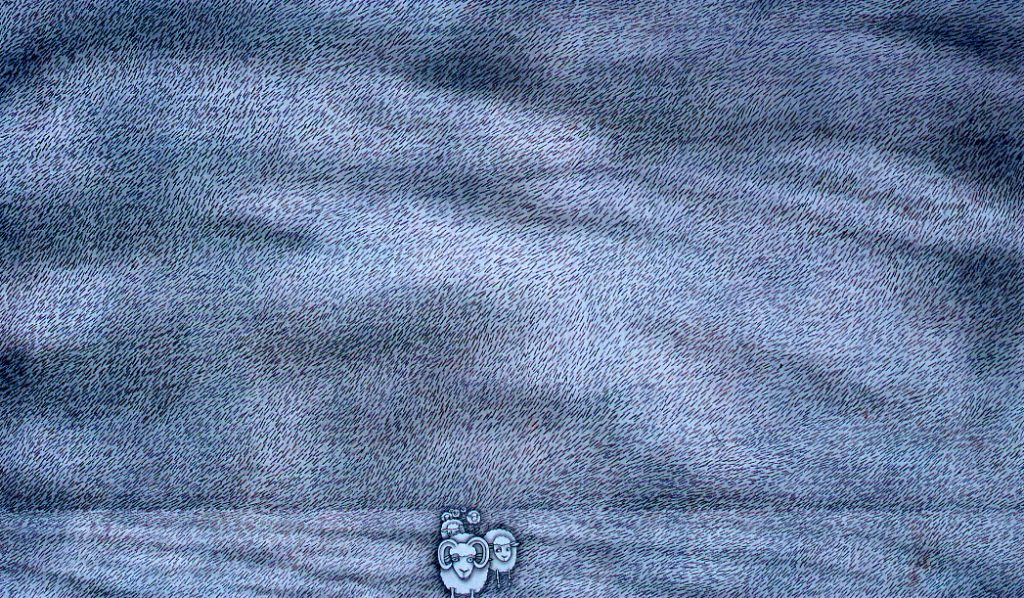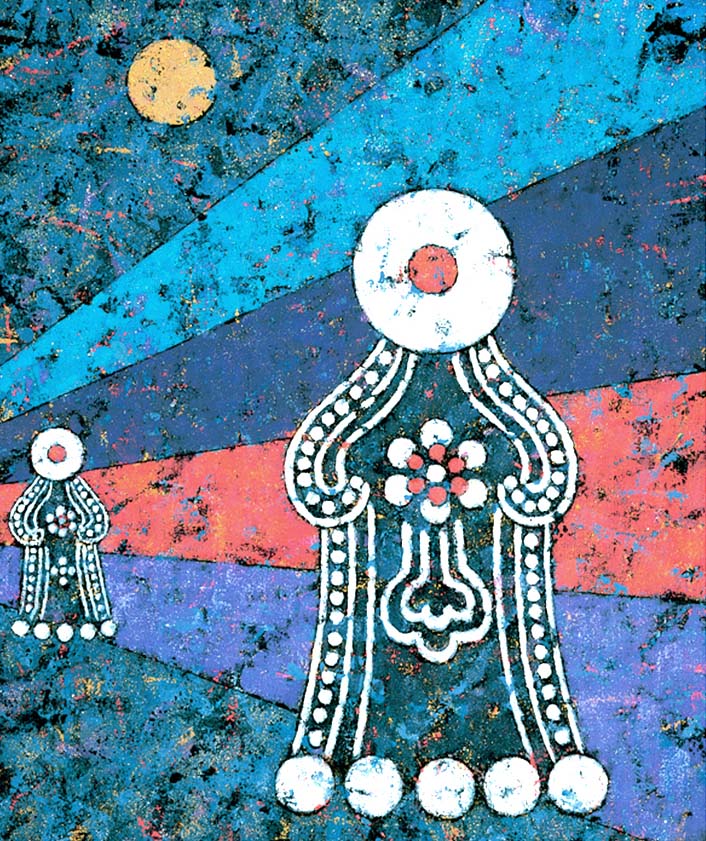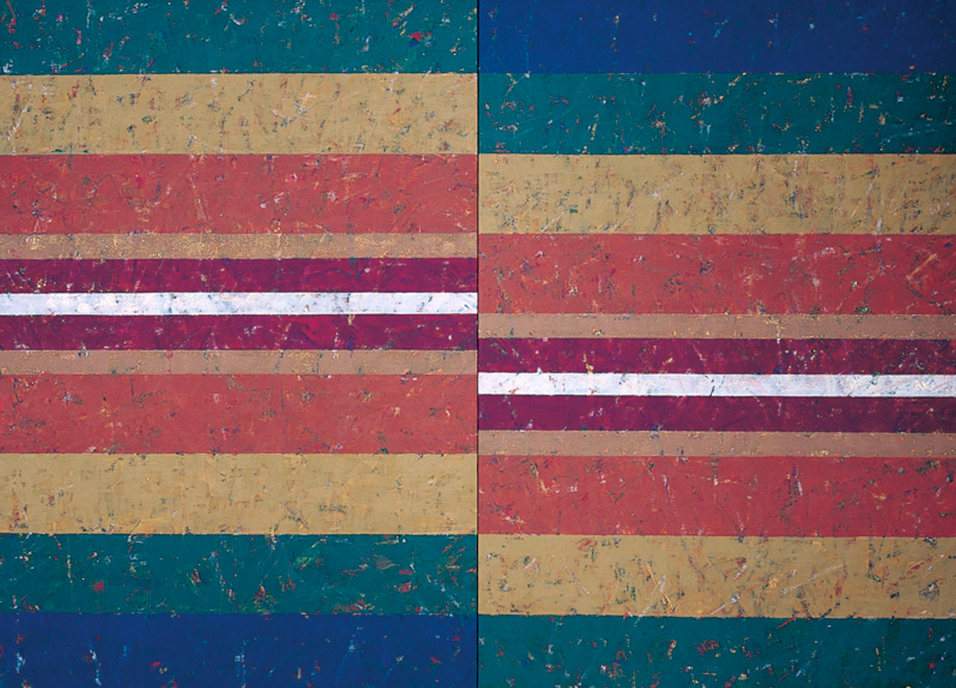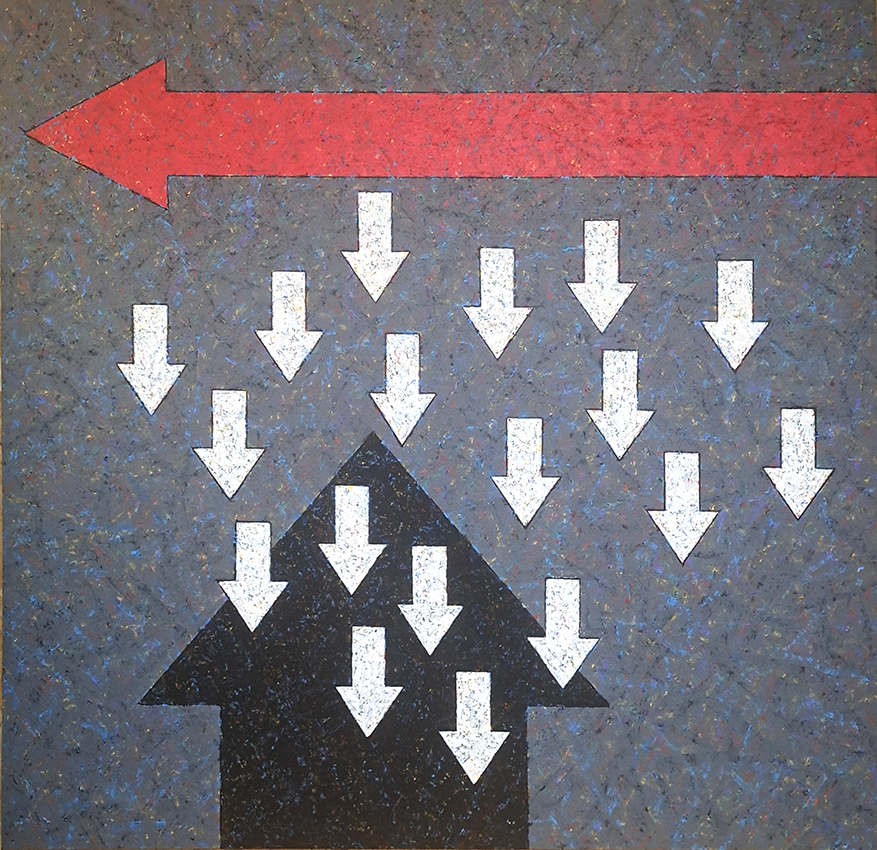评论 Reviews(按照姓氏拼音排序 / in alphabetical order)





8x.jpg)
范迪安(策展人/曾任中央美院院长)
无庸置疑,观念是当今画家特别看重的因素。没有观念的画只会留下一个平庸的空壳。然而,观念的获得又不应该是勉强的的体现,也不应该是生硬的,否则便流于浅显。熊文韵的这个系列有很强的观念性,她既为生命有秩序运动所激动,又不断困惑于同质机体总是处于分裂状态这样的事实。她要表达的就是这样一种矛盾与统一合二为一的观念,严格的说,她的这批画是一张画,只有整体的展现才有意思,才是一种观念的载体。
——摘自范迪安《观念与故事:熊文韵绘画文本的双重性》1998
方蕾(策展人/曾任宋庄美术馆馆长)
空空是一颗年轻的心灵,纯洁、有活力。调皮又狡黠。熊文韵依然使用了彩虹的颜色赋予他们性格。 甚至她把空空置换为另外一个自己,不停的对谈,谈话的内容是日常的、琐碎的、本质的。“空空”其实就是一个生命。熊文韵在不断的追问和修炼中平复自己。
——摘自方蕾《虹,和两手“空空”:熊文韵的生命故事》2014
冯博一(策展人/艺术评论家)
熊文韵的艺术教学计划和展示是针对我们当下的艺术教育现状,她在研究了国内外儿童美术教材的经验,并结合多年的艺术实践,同时吸收了韩国、日本、台湾以及欧美儿童美术教材的优势,制定出这一套学龄前幼儿美术教学计划,即引导孩子以绘画制作自己的故事绘本为中心线索的教学方案,同时把各种绘画方法技巧的学习有机地结合到教学过程中。
——摘自冯博一《又一堂课:儿童自主创作和操作的有益尝试》2006
贾方舟(策展人/艺术评论家)
在绘画技巧上,熊文韵充分吸收了藏传佛教壁画的特点和现代日本画重色彩,重材料的特点,形成了一套自己的制作方法和风格。她的画,色彩斑斓而和谐,丰富又厚重。为中国传统的工笔重彩画在材料和制作上的变革提供了一种参照。
——摘自贾方舟《熊文韵和她的画》1996
凯伦·史密斯(策展人/艺术评论家)
随着“流动彩虹”项目,熊文韵将这一绚丽色彩带进西藏。这一举动与其说是一种特定的艺术行为,不如说是一种慈善与祈祷,正如一些艺评人所描述:闪耀着纯粹的人性。她期望这些颜色能点亮自己曾于上世纪70年代,作为一位生机勃勃的少年参与公社劳动时生活过的地方。事实上,随着“流动彩虹”采用的方式,熊文韵像花衣魔笛手般,沿着川藏公路向青藏高原迈进,吸引了所有路途中遇见的目光。她的名片不是笛子的迷人音符,而是被她披在门道、卡车以及有时随意涂抹在表面上的纯色色块中充满几乎不可思议的能量。
——摘自凯伦·史密斯《十万彩虹熊文韵个展——馆长前言》2019
栗宪庭(策展人/艺术评论家)
我曾经说过重要的不是艺术,意思是艺术的好坏,在于你用什么标准来判断。在不同的语言系统里,有不同的一套价值系统。你建立了自己的体系出来,包括色彩。这不仅是学画,你把整个审美趣味,通过一个非常简单的流程告诉大家了。
——摘自栗宪庭《条条大路通罗马——栗宪庭&熊文韵对谈》2014
廖雯(策展人/艺术评论家)
《空空》拥有持续的“生命状态”——从孕育、出世到成长的完整过程,与艺术家个人日常生活的变化息息相关,与艺术家个人心理体验的纠结血脉相连,并且依然在“成长中”。《空空》拥有综合的“语言方式”——从传统的绘画,到当代的观念、摄影、行为、装置,到最时尚的动漫,从最古老的曼陀罗图示,到最前卫的混搭样式,到最女性、最原始的手工劳作,空空是中国当代艺术中最独特的作品。
——摘自廖雯《理解空空“自我”的另一种实现》2009
吕澎(策展人/艺术评论家)
熊文韵一开始仅仅是画出一个人物来,可是,即便是藏族的一个小小的物品,她也能够给予形象的引申。直到她将抽象的色彩条放进展览厅,她终于发现自己的艺术应该去表现在藏族服装以及复杂的文化要素中透露或提示出来的精神内涵。熊文韵几乎是本能地认可这样的内涵的重要性,这就是为什么她敢于独自进入荒芜人烟的地方感受自然的力量,并把自然的力量与自己对人生的认识结合起来,将那些色彩与石头、木头、门帘以及人们使用的东西结合起来,以传达内心的信息。
——摘自吕澎《流动的彩虹——熊文韵的艺术经历》2014
莫妮卡 · 德玛黛(策展人/艺术评论家)
小熊老师在这本为你们写的书里,教给你们绕过那些让很多人却步的障碍, 就像撰写过很多绘画教材的伟大日本艺术家葛饰北斋,熊老师深信我们每个人都能成功,经过了几十年的经验和尝试,熊老师明白不是“技巧” 让一件作品吸引人,而是它的特殊性,它的个性。
——摘自莫妮卡.德玛黛《画一个完全是你们自己的世界》2017清水敏男(策展人 /艺术评论家)
人类一面把自身当作自然的产物, 一面通过超越自然的努力构筑人类自身的存在。熊文韵的作品启示了隐藏在自然背后的秩序,将其展现给人们。通过她的行为艺术,西藏的房屋,人,生活,山岗,河谷,草原,岩石……所有的一切都成为了人为的风景。总之,所有一 切全部被包容进人类的理性和感性中去了。
——摘自清水敏男《宇宙的色彩》2002
西陲和东瀛,都不是熊文韵与生俱来的文化环境,但正是这情味迥然的两端,成为她艺术创作的两大支点。在我想象中,她是够辛苦的,她身心总是牵扯在遥远的两端,而她又是如此认真,如此认真地深入体会两种全然异趣的文化。这种辛劳、认真也渗透了她的作品,成为熊文韵绘画风格的组成因素。
——摘自水天中《从西陲到东瀛》1996
时玉玲(策展人/艺术评论家)
作为艺术家和艺术教育家,熊文韵从来不曾成为一个高深莫测的思辨者,也不是意识形态的斗士或者聪明机敏的游戏玩家。她更像是一个充满普世情怀的传教士,用一种无私的姿态在创作艺术、传播艺术。
——摘自时玉玲《”彩虹“与“错位”:关于熊文韵的艺术解读》2019
王檬檬(西安美术学院教授/策展人)
熊文韵的艺术一直离不开与社会交流,与普通人的对话,在艺术社会学还没有成为流行的中国,她以一己之力创造出跨越社会和艺术的桥梁,体现了艺术对于社会的价值。
——摘自王檬檬《十万彩虹前言》2019
易丹 (四川大学文新学院教授/艺术评论家)
熊文韵将这些行动指导符号从日常中抽离,在画面上重新组合、呈现,等于让它们形成了一套远离日常语境的构成关系。向左或向右,前进和停止,不再发挥日常功能,指涉日常意义,而只形成块面、构成、色彩、肌理等的相互关系,一句话:形成所谓艺术审美的关系。这样的关系,在通常的艺术意义和价值维度上,正好与抽象绘画的传统规律相吻合。
——摘自易丹《具体的抽象》2021
余玥(四川大学哲学系教授/艺术评论家)
医院过道的箭头成为了崭新世与消逝世的转涙点。它缥缈但实际的指示功能,将熊文韵引入生命与时代艺术的再次发问状态。它的形象被置于 “向 来” 文献展与主题展的结合部分。从这里出发,新的坛场开始结成,并远远超出了所谓 “疫情艺术” 可以涵盖的领域。生命政治,差异与重复,思维与历史中的定向,变成了一场有如《浮士德》般宏大的演出。
——摘自余玥《熊文韵:向来前言》2021
张黎(策展人/艺术评论家)
作为一个从艺近30年、多产和活跃的女艺术家,熊文韵在当代艺术领域独辟蹊径,作品跨越多种形式并自成体系。她善于将个人情感的外化表达与社会人文环境相结合,从最原初的个人感受出发,在与外部世界的结合中形成一种巧妙的形式和独特的语言。这些作品不只局限在展厅之内,而是在更广阔的空间中吸引更广泛的人群,同时又保持着非常单纯和直接的力量。
——摘自张黎《流动彩虹10周年》2008
张意(四川大学文新学院教授/艺术评论家)
熊文韵的箭头徘徊在抽象与具象之间,她没有急于抵达某种超越性的观念,没有迫切地删除感性的细节和印象,而是保持着足够的耐心,让箭头逐渐自由生成。此后,箭头突破了单一性肖像书写,以寓言式的准叙事,展开她对 2020 年之后不断重置的世界和生命格局的思考。
——摘自张意《向来的隐形剧场》2021

观赏这些作品,也许有人简单的认为是“抽象画”,有人则恰恰相反,认为是“平面设计”,只是起到装饰作用。然而,这类意见却失之偏颇。熊文韵的作品是长年潜心研究的喷发,是一种革命,是显示现代尖端精神的纯粹的“造型艺术”。既非设计,亦非美术,这就是前卫的“造型作品”。
——摘自朝昌直已《凝视未来的造型精神》1997
Fan Di’an
Curator, Former Director of CAFA
Undoubtedly, the concept is a factor of special importance to today’s painters. Paintings without concepts will only leave an empty shell of mediocrity. However, the acquisition of concepts should not be a forced embodiment or a rigid one, otherwise it would be superficial. This series of Xiong Wenyun’s paintings are highly conceptual: she is both constantly excited by the orderly movement of life and puzzled by the fact that homogeneous organisms are always in a state of division. What she wants to express is the concept of contradiction and unity as one. Strictly speaking, her paintings are a single painting, which is only interesting when presented as a whole, and are the carrier of a concept.
——Extracted from Fan Di’an’s “Concept & Story: The Duality of Xiong Wenyun’s Drawing Texts” 1998
Fang Lei
Art Critic, Former Director of Songzhuang Art Museum
Kongkong is a young mind – pure, energetic, naughty an and mischievous. Xiong Wenyun continued to use the colors of the rainbow to give them character. She replaces Kongkong with herself, with endless talking——daily, trivial and essential. Kongkong is after all a life. Xiong Wenyun calms herself in endless asking and practice.
——Extracted from FANG Lei’s “Rainbow and Kongkong: Life Stories of Xiong Wenyun” 2014
Feng Boyi
Curator, Art Critic
The art education plan and display of Xiong Wenyun are in response to our the current state of our art education. She has studied the materials of art education domestically and internationally, combined with her own art practice of years, and, at the same time, she absorbed the advantages of art education materials in Korea, Japan, Taiwan, Europe and America, to make a series of art education plans for preschool children: a teaching program that guides the child to draw and make his or her own picture book of a story as the central clue, and at the same time organically combines the learning of various drawing methods and techniques into the teaching process.
——Excerpted from FENG Boyi’s “Another Lesson: A Beneficial Experiment in Children’s Independent Creation and Operation” 2006
Jia Fangzhou
Curator, Art Critic
Speaking of the drawing skills, Xiong Wenyun has developed her own method and style after she fully absorbed the characteristics of Tibetan Buddhist mural paintings, and the modern Japanese paintings that attach great importance to colors and materials She has formed a set of own fabrication method and the style. Her works are variegated, harmonious, rich ih and heavy. She provided a reference to transformation in materials and fabrications of traditional Chinese fine brushwork paintings with intense color and also delivered a worthy topic for us.However, there is s a drawback that the works feel simplified inevitably, as a result of pursuing simple and artless modeling.
——Extracted from Jia Fangshou’s “Xiong Wenyun and Her Paintings” 1996
Karen Smith
Curator, Art Critic
With the Flowing Rainbow, Xiong Wenyun took this palette of glorious colour to Tibet in what was conceived less as a specific act of art, than as an act of charity, supplication and, as some commentators have described, of pure humanity. Her goal was to brighten the lives of communities that she had encountered herself as a bright young teenager back in the 1970s. In effect, with the approach and form that The Flowing Rainbow took, Xiong Wenyun was like a Pied Piper moving along the highway towards the Tibetan plateau, capturing the attention of all who saw her. Her calling card was not the alluring notes of a flute, but the almost magical power of those pure blocks of colour that she draped over doorways, over trucks and, on occasion, daubed on random surfaces.
——Extracted from Karen Smith’s “Director’s Foreword” 2019
Li Xianting
Curator, Art Critic
I have said that art is not the most important, by which l mean judging an artwork to be fine or poor depend s a lot on the standards you use. In different language systems, value systems are different. This is not only about learning painting, but also about sharing the entire aesthetic interest with everyone through a very simple process.
——Extracted from LI Xianting’s “All Roods to Rome -The Dialogue between Li Xianting and Xiong Wenyun” 2014
Liao Wen
Curator, Art Critic
The life of “Kongkong” is continuous — from pregnancy to birth to growth, closely bound up to the changes of the artist in the daily life and the entanglement of her personal psychological experience. Moreover Kongkong is still “growing.” “Kongkong” has comprehensive “language form” — from the traditional painting to the contemporary concepts, to photo, performance and installation, to the most fashionable animation, to the most ancient datura illustration, to the utmost paired up patterns, to the most feminine handicraft labor.
——Extracted from Liao Wen’s “Understanding Kongkong: Another Way of Self-Realisation” 2009
Lv Peng
Curator, Art Critic
Xiong Wenyun began by simply painting a figure, but, even if it was a small Tibetan item, she was able to derive from figuration. It was not until she put the abstract color stripes into the exhibition hall that she finally realized that her art should express the spiritual connotations revealed or hinted at in the Tibetan clothing and its complex cultural elements. Xiong Wenyun instinctively recognized the importance of such meanings, which is why she dared to venture into deserted places alone to feel the power of nature and combined the power of nature with her own understanding of life, integrating the colors with rocks, wood, curtains and things people utilize in daily life to convey inner messages.
——Extracted from Lv Peng ‘s “The Flowing Rainbow: The Artistic Experience of Xiong Wenyun” 2014
Monica Dematte
Curator, Art Critic
In this book written for you, Ms. Xiong teaches you to bypass the obstacles that keep many people away. Like the great Japanese artist Katsushika Hokusai, who wrote many painting textbooks, Ms. Xiong is convinced that each of us can be successful, and that after decades of experience and experimentation, Ms. Xiong understands that it’s not the “technique” that makes an artwork appealing, but its specialness and its individuality.
——Excerpted from Monica Dematte’s “Draw a World Completely Your Own” 2017
TOSHIO Shimizu
Curator, Art Critic
Human beings treat themselves as the products of nature, and at the same time construct their own existence through their efforts to transcend nature. Xiong Wenyun’s works reveal the order hidden behind nature and show it to people. Through her performance art, Tibetan houses, people, life, mountains, valleys, grasslands, rocks……all become artificial landscapes. In short, everything has been incorporated into human rationality and sensibility.
——Excerpted from TOSHIO Shimizu’s “The Colors of the Universe” 2002
![]()
Art Critic
The West (of China) and the East (Japan), neither of them is de facto her own cultural environment, though extremely differentiated from each other, have become the two essential keys in her creative process. I myself would assume that she would work very hard and always ruminating on these two remotely related places, but she is also very diligent and determined so much so that she would delve deeper into those cultures that are absolutely disparate. Xiong Wenyun’s vigorous endeavor and resolution that permeate through the works form the style of her paintings.
——Extracted from Shui Tianzhong’s “From the West to the East” 1996
Shi Yuling
Art Critic, Curator
As an artist and art educator, Xiong Wenyun has never been an inscrutable thinker, nor is she an ideological warrior or a clever and agile game player. She is more like a missionary full of universal values, creating and spreading art with a selfless gesture.
——Extracted from Shi Yuling’s “’Rainbow’ and ‘Displacement’: Interpreting Xiong Wenyun’s Art” 2019
Wang Mengmeng
Professor, Curator
Xiong Wenyun’s art has always been inseparable from social communication and in dialogue with ordinary people. In China, where art sociology has not yet become popular, she has created a bridge between society and art with her own efforts, reflecting the value of art to society. ——Extracted from Wang Mengmeng’s “Preface to A thousand Rainbow” 2019
Yi Dan
Professor, School of Literature and Journalism, Sichuan University, Art Critic
Xiong Wenyun separates these action guidance symbols from daily life and reassembles and presents them on the paintings, letting them forming a set of constitutive relationships that are far away from daily contexts. To the left or right, to move forward and stop, no longer perform daily functions, point to daily meanings, but only form mutual relationships between shapes, compositions, colors, textures, etc. In one sentence: they form the so-called relationship of artistic aesthetics. This relationship, in its usual artistic significance and value dimensions, coincides with the traditional laws of abstract painting.
——Excerpted from Yi Dan’s “Concrete Abstraction” 2021
Yu Yue
Professor, Philosophy Department, Sichuan University, Art Critic
The arrow in the hospital hallway has become a turning point between the brand new world and the passing world. Its ethereal but practical indicative function introduces Xiong Wenyun into the questioning state of life and contemporary art. Its image is placed in the intersection of the documentation section and thematic section of the “Recover” exhibition. Starting from here, a new mandala has begun to form, far beyond the scope of the so-called “pandemic art”. Life politics, differences and repetition, thinking and orientation in history, they have become a performance as grand as Faust.
——Excerpted from Yu Yue’s “Exhibition Preface of Re-cover” 2021
Zhang Li
Art Critic, Curator
As a prolific and active female artist with 30 years of practice, Xiong Wenyun has taken a unique approach to the field of contemporary art, with her works spanning a wide range of forms and forming her own system. She is good at combining the externalized expression of her personal emotions with the social and humanistic environment, starting from the most original personal feelings and forming and ingenious form and unique language. These works are not confined to the exhibition hall, but appeal to a wider audience in the wider space, while maintaining a very pure and direct force.
——Extracted from Zhang Li ‘s “Ten Years of the Flowing Rainbow” 2008
Zhang Yi
Professor, School of Literature and Journalism, Sichuan University, Curator
Xiong Wenyun’s arrows lingers between abstraction and figuration. She does not rush to reach a certain transcendental concept, nor does she urgently delete sensual details and impressions. Instead, she maintains enough patience to allow the arrows to gradually generate freely. Afterwards, the arrows break through the singular portrait narrative and unfolds her contemplation of the constantly resetting world and life patterns after 2020 through fable-like quasi-narratives.
——Extracted from Zhang Yi ‘s “The Hidden Theatre of ‘Re-Cover’” 2021
![]()
Professor at University of Tsukuba, President of the Basic Art Design Association of Japan
Looking at these works, some people simply regard them as “abstract painting,” while others believe they are “graphic design” that only perform the function of ornamentation. However, these types of opinions are biased. The works of Xiong Wenyun are an eruption after years of painstaking research, a kind of revolution, and revolutionary and pure “fine art” envisioning the modern the spirit. Neither design nor art, they are pioneering objects of “fine art.”
——Extracted from ASAKURA Naomi’s “Perceiving the Future Spirit of Fine Art” 1997
